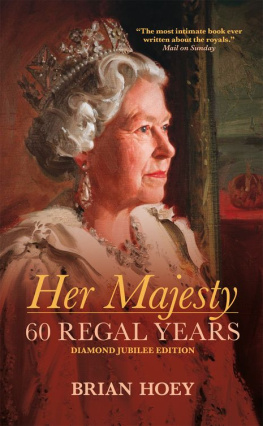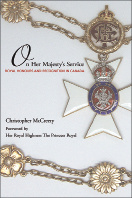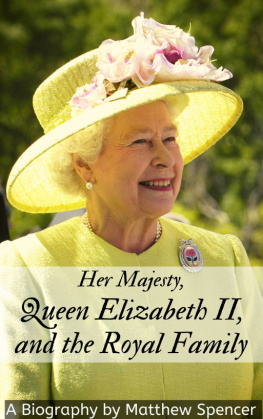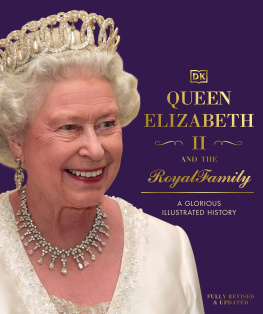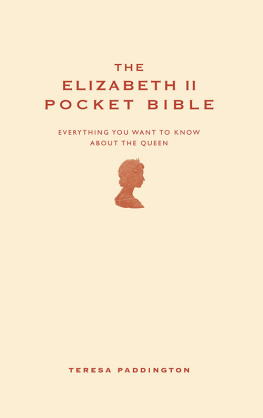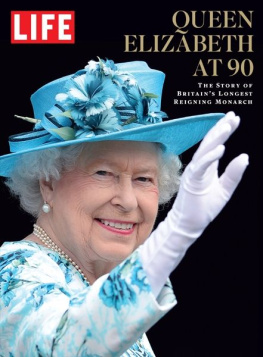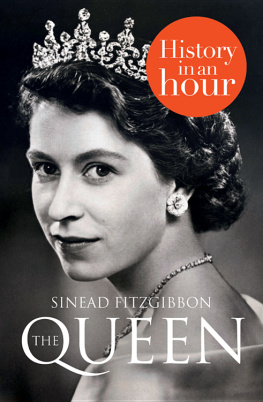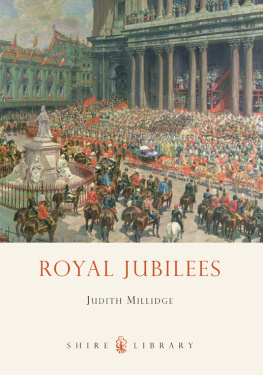T he preparations for this book began more than ten years ago, when I was researching a project concerning The Queens Golden Jubilee. Some of the men and women I spoke to then are no longer with us, but their contributions were so valuable I believe it is important and apposite to include them now.
I am indebted to a great many people for their contributions and other assistance during the preparation of this book. Past and present members of the royal household have been generous with their time and expertise: some I am able to name; others have asked me to respect their confidentiality. Friends of The Queen and Prince Philip spoke openly and also provided me with some unique photographs.
Among those to whom I am particularly grateful are the following: Ronald Allison, Harry Arnold, Dame Jocelyn Barrow, James Beaton GC, Countess Mountbatten of Burma, ex-President George Bush and Mrs Barbara Bush, Lady Myra Butter, the late Earl of Carnarvon, Lord Carrington, Marge Champion, Geoffrey Crawford, Michael Dannenhauer, Lady de Bellaigue, the late Lord Deedes, Oliver Everett, Paul Flynn MP, Bryan Forbes, the late President Gerald Ford, the late Princess George of Hanover, Geordie Greig, Lorna Hogg, Sir Bernard Ingham, the late Lady Georgina Gina Kennard, Lord (Neil) Kinnock, Dr Henry Kissinger, Lee Kuan Yew, Austin Mitchell MP, Christina Neuman, Lord (David) Owen, Andrew Parker Bowles, Colin Parker, David Rankin-Hunt, Maureen Rose, Ashley Walton, the late James Whitaker, Alan Williams and George Wiltshire.
I was also fortunate enough to be allowed to speak to the late Lord Runcie just a few weeks before he died. Although in considerable pain, he gave no indication of his discomfort. I am glad to record my appreciation of his unfailing courtesy and good humour.
Similarly, the late Douglas Fairbanks Jr and his wife Vera were equally kind in corresponding with me in spite of his illness.
My thanks must also go to Sam Carter and Jessica Feehan for their constructive editing and to their colleagues at Biteback Publishing; to Gordon Wise and his colleague John Parton at Curtis Brown for their unfailing efforts on my behalf; and to Janice Robertson, to whom I owe a massive debt for her extraordinary energy and perception when editing the original manuscript.
This book has not been vetted by Buckingham Palace, or anyone else; therefore any opinions that are not attributed are mine and mine alone as are any errors.
I ts hard to believe, but when The Queen came to the throne in 1952 she was younger than four of her grandchildren Princes William and Harry, and Peter and Zara Phillips are today.
Her Majesty, who was born in 1926, was just twenty-five when she learned she was now Britains forty-second sovereign since William the Conqueror, and only its sixth Queen Regnant. She was also the second youngest to inherit the throne in two centuries only her great-great-grandmother was younger, eighteen, when she became Queen Victoria in 1837.
On 5 February 1952 she was still Her Royal Highness Princess Elizabeth. She had been married for just under five years and was the mother of two small children: Prince Charles, born in 1948, and Princess Anne, born in 1950; Andrew and Edward did not arrive until 1960 and 1964. The following day, 6 February, she was informed that she was now Her Majesty Queen Elizabeth II, following the sudden death of her father, King George VI, at Sandringham, his favourite home in Norfolk.
The Queen had been at the romantically named Treetops Hotel in the Aberdare National Park, Kenya, when the Duke of Edinburgh (he wasnt even Prince Philip then it was to be another five years until he was created a Prince of the United Kingdom by his wife) informed her of the change of circumstances that would alter both of their lives forever.
The next day they returned to a grey and sombre Britain to be greeted by the Prime Minister, Winston Churchill, accompanied by the Leader of the Opposition, Clement Attlee, and the Foreign Secretary, Anthony Eden. Churchill, who had been born in the reign of Queen Victoria, would later remind his young sovereign that he had first held public office when her great-grandfather, King Edward VII, was on the throne.
Today, Elizabeth II is by far the most experienced states-woman in the world, having occupied her unique position longer than the six popes, twelve United States presidents and countless prime ministers and monarchs elsewhere in the world who have come and gone during her reign. In Britain, two of her last three Prime Ministers Tony Blair and David Cameron were not even born when she ascended the throne, while Gordon Brown was still a toddler and had not yet celebrated his first birthday.
The Queen is the first female sovereign to bear the family name of Windsor, which was adopted by her grandfather, King George V, in 1917 in order to avoid mounting public criticism and suspicion of his familys original name, Saxe-Coburg-Gotha , when Britain was at war with Germany. In 1960, in spite of opposition from The Queen Mother, Prince Philips surname, Mountbatten, was formally added to the Windsor family name. Like the rest of King George Vs relations, Philips ancestors had been forced to abandon their German-sounding names, so Battenberg became Mountbatten.
Throughout the sixty years The Queen has reigned, her success as sovereign has remained unchallenged; her greatest disappointment has been as a parent, facing the divorces of three of her four children: Charles, Anne and Andrew. Earlier in her life, she had also been deeply saddened when the marriage of her only sister, Princess Margaret, to Lord Snowdon broke up in 1978.
The Queen is an affectionate wife, loving mother, doting grandparent and now great-grandparent, but the quality she possesses in abundance above all others is single-minded devotion to duty. Nothing, not even personal or familial happiness, has been allowed to interfere with the never-ending business of monarchy.
Even in her late eighties three decades past the official retirement age for women she still carries out more than 500 public engagements each year, both at home and abroad. In 2011, accompanied by her ninety-year-old consort, she travelled halfway around the world to Australia, where she was visibly moved by the reception she received. And she made history by becoming the first British sovereign to visit Ireland since the country became a republic.
Her Majesty is also, surprisingly to some, a realist and a pragmatist , and is determined that the House of Windsor becomes a modern, if not entirely democratic, institution.
Elizabeth II believes in transparency regarding royal finances her decision to pay income tax was a public relations triumph at a time when critics of royalty claimed that The Firm was simply a bastion of privilege and outmoded ceremony.
She has also introduced a personal style of monarchy previously unknown and it is solely due to her that the image of royal remoteness has, in the main, diminished if not entirely disappeared. For example, during her reign men and women have finally been permitted to turn their backs on their sovereign . This came about simply because of an occasion when an elderly diplomat, retreating from her presence, tripped over his dress sword and fell over backwards. Stifling her giggles, The Queen decided there and then that this ridiculous tradition had to go and it did immediately, no doubt earning the gratitude of many later attendees at formal audiences.
Throughout her reign, Her Majesty has carried out her duties with flawless professionalism and immeasurably strengthened the role of the constitutional monarch, while accepting with grace the reduced circumstances of a once all-powerful position.
Furthermore, in many of her speeches she has displayed a unique ability to say something meaningful without causing offence, even when it comes to uncomfortable topics: the sporadic moves towards republicanism in Australia, New Zealand and parts of Canada, for example. These are often subjects that so obviously would involve her personally, but no listener could possibly even hazard a guess as to her own thoughts and opinions.

